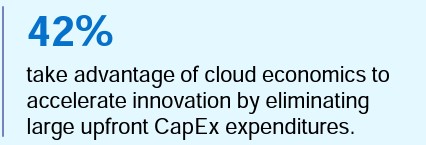By Matt Dunfee, senior vice president, global presales, Dell Technologies
Economic uncertainty. Regulatory changes. Rapidly shifting customer demands. An ongoing talent shortage.
Given these and other external challenges, it’s no wonder nearly six in 10 business and IT leaders (57%) fear their organization won’t be relevant in just three to five years, according to the Dell Technologies Innovation Index.
The challenges impact IT organizations everywhere as leaders work to adapt to change, meet business objectives, and harness data – and do so responsibly.
In managing finite resources, some organizations adopt capital expense (CapEx) strategies that safeguard on-premise IT investments but add the risk of falling behind as cloud technologies advance. Others go all in on the cloud with operational expense (OpEx) approaches that risk adding unsustainable ongoing costs. Still, others opt for a mix of OpEx and CapEx operating models, creating every permutation in between.
As a result, the broader challenge for the enterprise becomes managing a sprawl of IT decisions that may add unnecessary expense, duplicate effort, and hamper the agility and innovation needed to address the external challenges.
A multicloud strategy can help.
Expanding challenges, proliferating decisions

Enterprise IT teams face a perfect storm of priorities from business leaders responding to external challenges. These priorities pressure IT leaders to do more with less as they get operations teams to innovate while addressing expanding regulatory frameworks around data.
- Business pressure drives time-to-value mandates that increase as business units race to exploit technology in the quest to deliver better experiences, goods, and services to customers. The prize for those who get there first: increased revenue and greater market share.
- Financial pressure squeezes IT as budget constraints challenge companies’ ability to invest in new digital technologies to reshape their businesses. As a reflection of such constraints, nearly seven in 10 IT leaders (68%) believe their own leaders prioritize day-to-day operations over innovation, according to the Dell Innovation Index.
- Operational pressure increases as operations and development teams compete for resources. Companies struggle to extract their technology teams from the day-to-day burdens of keeping up with internal demands to deliver greater value to the business through new technology initiatives.
- Skills and talent shortagesthat might otherwise ease the operations-versus-development problem show no signs of abating. This challenge is particularly acute around emerging technologies such as artificial intelligence (AI). For example, expertise in data science or high-performance computing (HPC) doesn’t necessarily translate to expertise in generative AI.
- Regulatory and security requirements continue to expand around privacy, trust, data sovereignty, and more in response to new threats and consumer concerns about businesses’ use of their data. Emerging regulations require new approaches to collecting, using, and sharing data.
All these pressures and potentially competing priorities increase the risk of IT decision sprawl that could solve problems in one area while adding complexity in others.
Tackling challenges and reducing complexity with multicloud
Multicloud approaches to IT can ease the pressure by letting organizations address challenges on a case-by-case, workload-by-workload basis without added complication or unnecessary cost.
Multicloud strategies provide technical, business, and financial flexibility through:
- Speed, thanks to the ability to deploy technologies and workloads anywhere, anytime, including on-premises, making small-scale experiments possible before investing in them on a larger scale
- Scale, allowing pilot programs to expand and operations to grow with new business opportunities, from the scale of a single factory or retail outlet to multiple manufacturing centers and stores
- Financial flexibility, taking in a range of operating scenarios, including both CapEx- and OpEx-focused strategies, depending on total cost of ownership considerations and business forecasts
- Control, letting organizations operate in multiple regulatory environments and regions and meet varying audit requirements
Taking the first step
The first step for organizations to avoid IT decision sprawl and realize the benefits of a multicloud strategy is to approach spending decisions horizontally rather than vertically. That means, instead of individual IT leaders asking financial departments for approval on given IT investments, IT and business leaders partner early and often on decisions that impact everyone.
Successful teams ask questions in four key areas:
- Overall business outcomes needed to meet revenue and market share goals
- Use cases to address now and in the future, with business forecasts and emerging technologies in mind
- Projects in the planning stages that may introduce the risk of duplicating efforts
- Best financial constructs given all the above and taking into account different CapEx and OpEx operating models
Answering questions in these areas helps companies align horizontally rather than vertically on IT decisions.
Building multicloud frameworks
With everyone on the same page, companies can align around agreed-upon frameworks for addressing challenges and meeting business, technology, and financial objectives. The frameworks also provide guardrails to keep them out of costly predicaments, for example, budget-busting recurring expenses.
At Dell, we help companies develop individualized multicloud frameworks that don’t have technology dictating financial considerations.
Instead, these frameworks address each company’s specific needs for financial sustainability, new vs. existing workloads, software vs. hardware requirements, security and compliance, and more. Prioritizing such considerations at the onset streamlines decision-making and helps organizations get where they need to go much faster than possible with uncoordinated, ad-hoc solutions.
Don’t let the allure of OpEx-only consumption models risk meeting your financial obligations. Technology is accelerating business innovation, and the most effective way to seize the opportunity is to strengthen alignment between business priorities and technology enablers. My advice to leaders is- don’t make compromises along the way. Work with partners that are uniquely positioned to build a multicloud framework that leverages the best of enterprise infrastructure wherever you need it, however you choose to consume it, in a CapEx, OpEX or Hybrid financial constructs that exceeds your goals. All to reduce risk and accelerate innovation.
Lead photo courtesy of Getty Images

